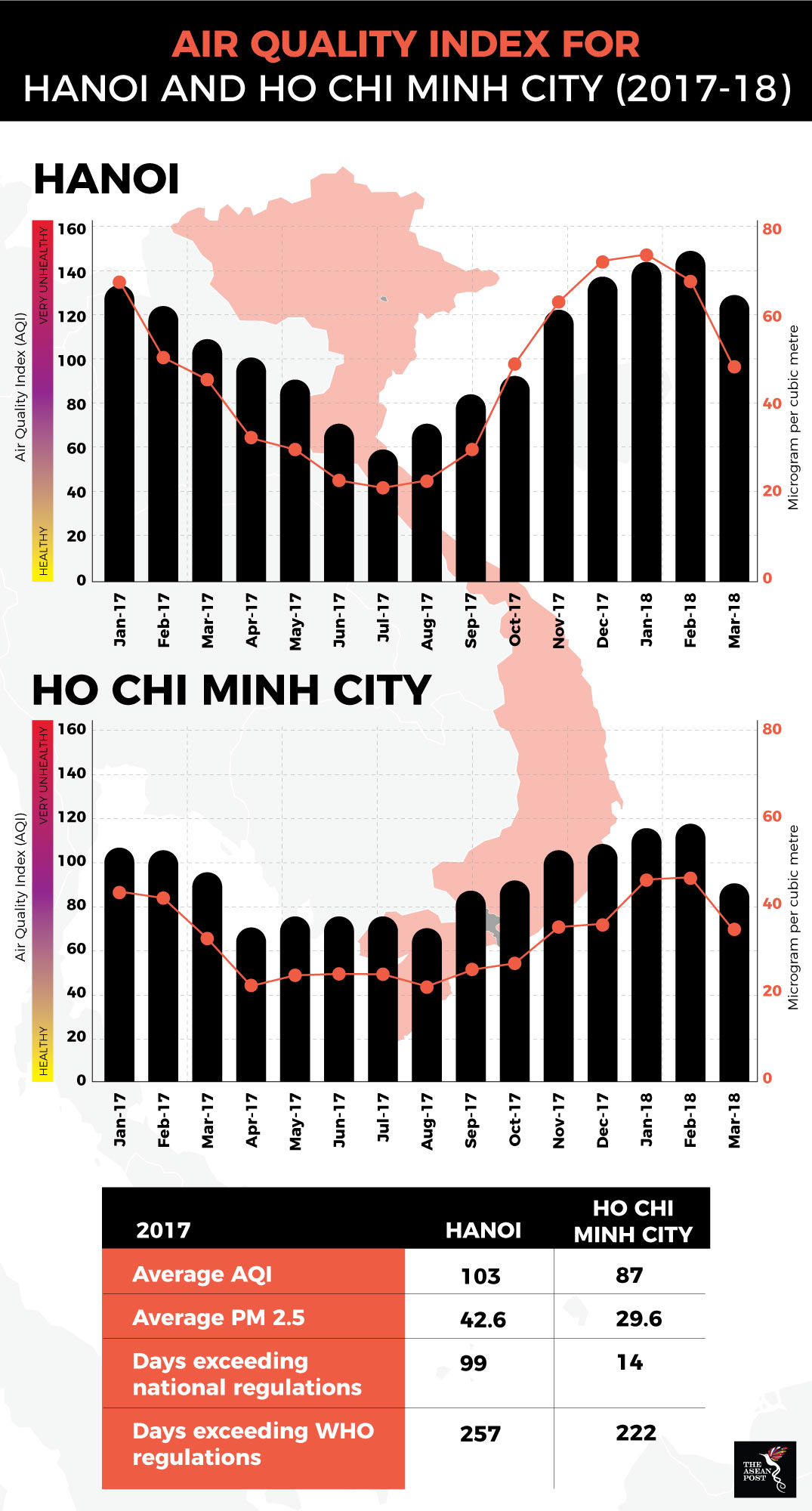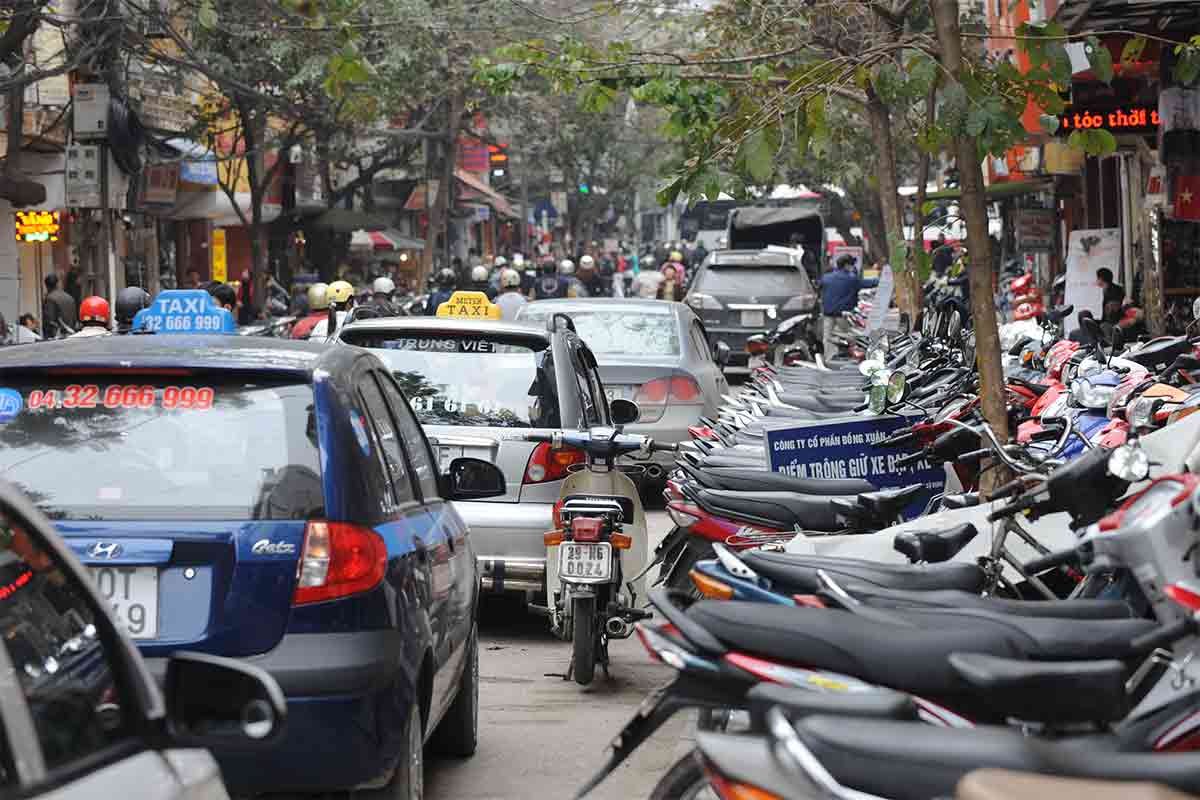The city of Hanoi is choking in air pollution and its city council hopes to reduce it by banning motorcycles from the inner city by 2030. The city aims to remove some 2.5 million old motorcycles from its streets between now and 2020.
Hanoi, with an estimated population of 7.8 million people, is considered one of the most air polluted cities in Southeast Asia with its air quality consistently rated as “Moderate” to “Unhealthy” throughout 2017. The air is usually more polluted during its winter months from November to February than summer.
Ambient air quality is usually measured by the number of inhalable particles in the air, categorised as coarse particulates, PM10 (with a diameter between 2.5 and 10 micrometres) and fine particulates, PM2.5 (with a diameter of 2.5 micrometres or less).
Fine particulates pose the greatest risks to human health, said the World Health Organization (WHO), as they may penetrate deep into the lungs and enter the blood stream unfiltered. In 2016, it estimated that PM2.5 pollution caused 4.2 million premature deaths per year, due to cardiovascular and respiratory disease, and cancers.
The WHO has set an annual mean of 10 micrograms per cubic metre and a 24-hour mean of 25 micrograms per cubic metre as the threshold for safety.
By this standard, Hanoi’s air quality has failed miserably. Its monthly averages for PM2.5 ranged from 21.3 to 74.5 micrograms per cubic metre in 2017 and peaked at 76.1 in January this year. The pollution level fell within the WHO’s guidelines for only 108 days for the whole of last year. Vietnam’s national limit is more lenient, at 50 micrograms per cubic metre. Even so, 99 days were reported to have exceeded those levels last year.
 Source: Green Innovation and Development Centre
Source: Green Innovation and Development Centre
The WHO recently issued a report that said more than 60,000 deaths from heart disease, stroke, lung cancer, chronic obstructive pulmonary disease and pneumonia in Vietnam in 2016 were linked to air pollution.
The United States Environmental Protection Agency (US EPA) introduced the Air Quality Index (AQI) to measure five major air pollutants: ground-level ozone (O3), particulate matter, carbon monoxide, sulphur dioxide (SO2) and nitrogen dioxide (NO2). Air quality is categorised as Good, Moderate, Unhealthy for Sensitive Groups (USG), Unhealthy, Very Unhealthy and Hazardous, in descending order. Hanoi averaged a Moderate AQI in the summer months and ranged from USG to Unhealthy during the others.
The Green Innovation and Development Centre (GreenID) conducted a study on PM2.5 pollution in Hanoi and found the southeast of the city to be a major source of residential fuel-burning emissions. This is where dense rural and urban populations are located.
Vietnam’s largest concentration of power plants and industrial facilities is located about 100 km to the east of Hanoi. Here, at the Quang Ninh industrial cluster, is the largest hotspot for NO2, SO2 and PM2.5 emissions.
A survey conducted by GreenID found that 83 percent of respondents blamed transportation as the main cause of pollution, followed by industrial production (79 percent), thermal power plants (71.4 percent) and construction (60.9 percent).
Motorcycles are a popular mode of transport in Vietnam. An estimated 8,000 new motorcycles are registered in a day. Hanoi is expected to have 6.1 million motorcycles by 2020, seven million by 2025 and 7.5 million by 2030.
Hanoi’s city council voted unanimously in July 2017 to ban the over-5.2 million motorcycles that ply its streets daily. It is executing the ban in stages. First, authorities will phase out old motorcycles that fail to meet emission standards. These vehicles will be banned after 2020.
From 2025 to 2029, motorcycles will be prohibited during certain hours and on certain days in some districts and on major roads. From 2030 onwards, motorcycles will be banned from the inner city.
Replacing one problem with another
However, Hanoi may be substituting its motorcycle problem with a bigger one – cars. Citizens fear the city is getting rid of motorcycles, the transport mode of choice for the lower income group, to make way for the rich and their cars.
BMI Research projects total vehicle sales in Vietnam to cross 284,400 units in 2018. It said passenger car demand will be driven by the elimination of tariffs on imports from ASEAN member countries this year and a reduction in tax rates for vehicles with 2.0 litre capacity engines or less. Vietnam is home to several major automobile manufacturers, such as Ford, General Motors, Honda, Mercedes-Benz, Nissan, Toyota, Kia and Mazda.
To convince the public to switch to public transport, the government is constructing a rapid transit system, the Hanoi Metro, to complement its existing bus network. There are presently over 100 intra-city bus routes operating under government subsidy.
The Hanoi Metro will comprise eight lines with a total length of 318 km. Two lines are currently under construction: The Cat Linh – Ha Dong Line is expected to begin operations in November this year; and the Nhon – Hanoi Station segment of the Kim Ma Line which is targeted for completion in 2021.
It may take some time and effort to persuade Hanoians to give up their private vehicles for public transportation. With any luck, the sight of tourists frozen at the sidewalk trying to cross a busy street and death-defying locals wading into a seemingly non-stop stream of motorcycles, will be a thing of the past.
